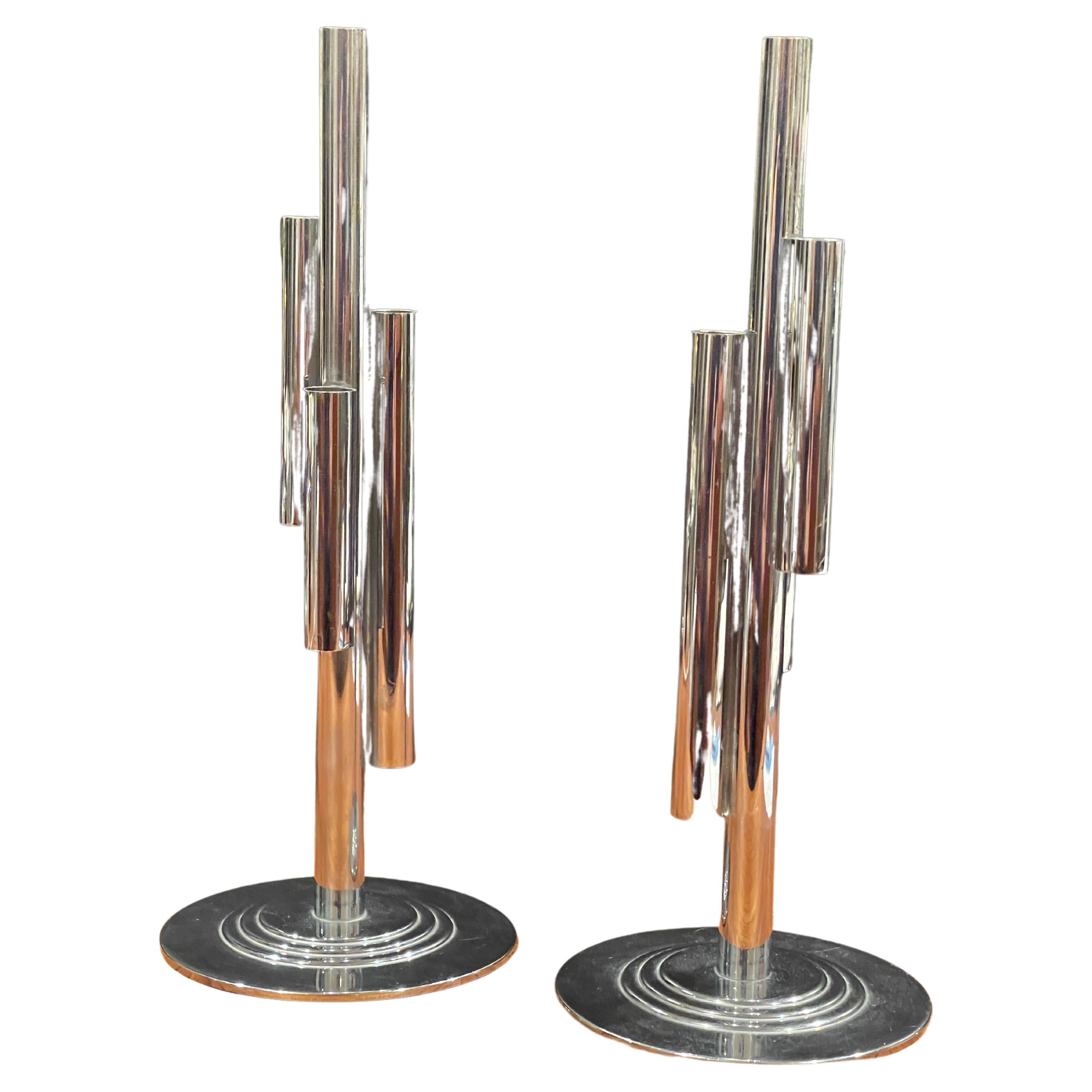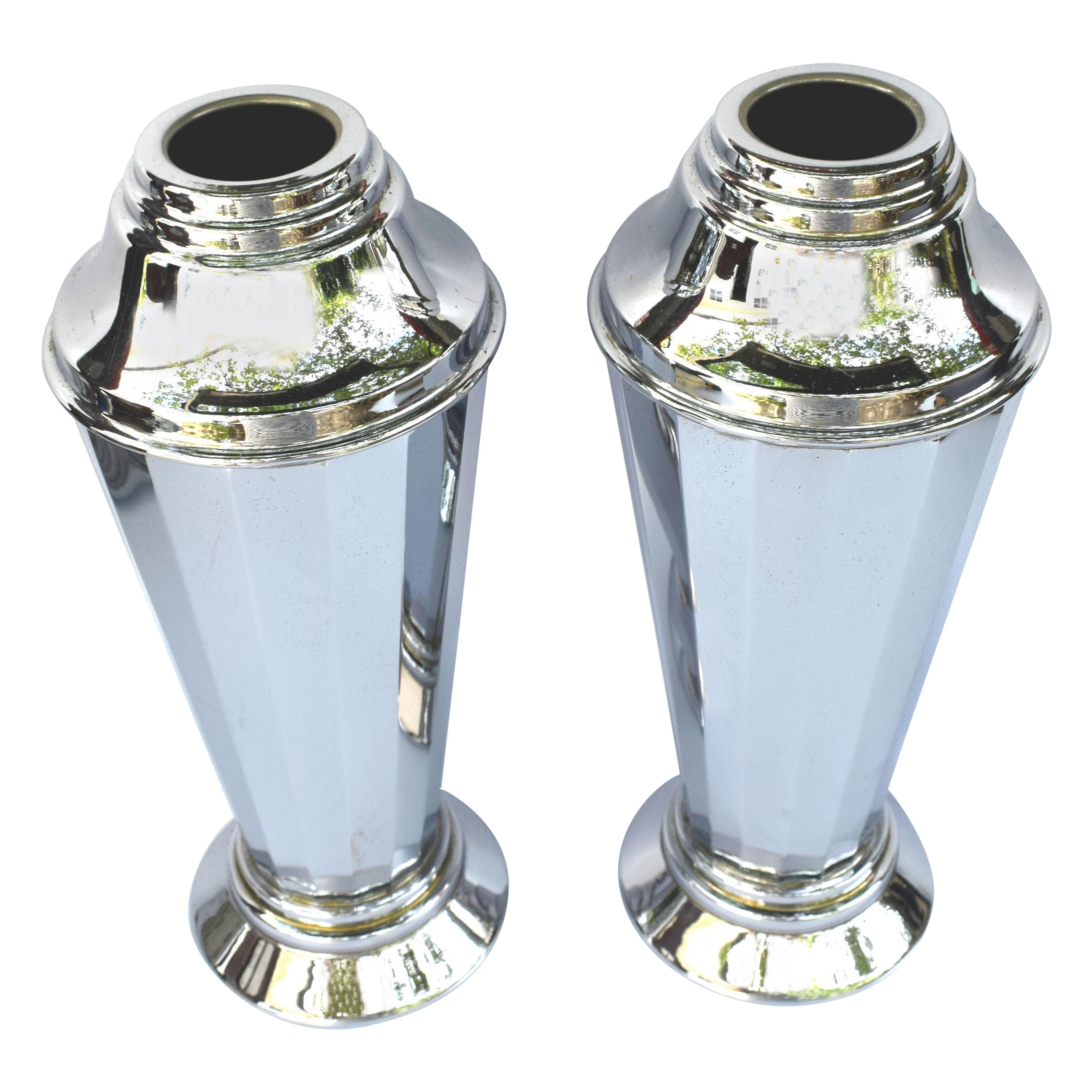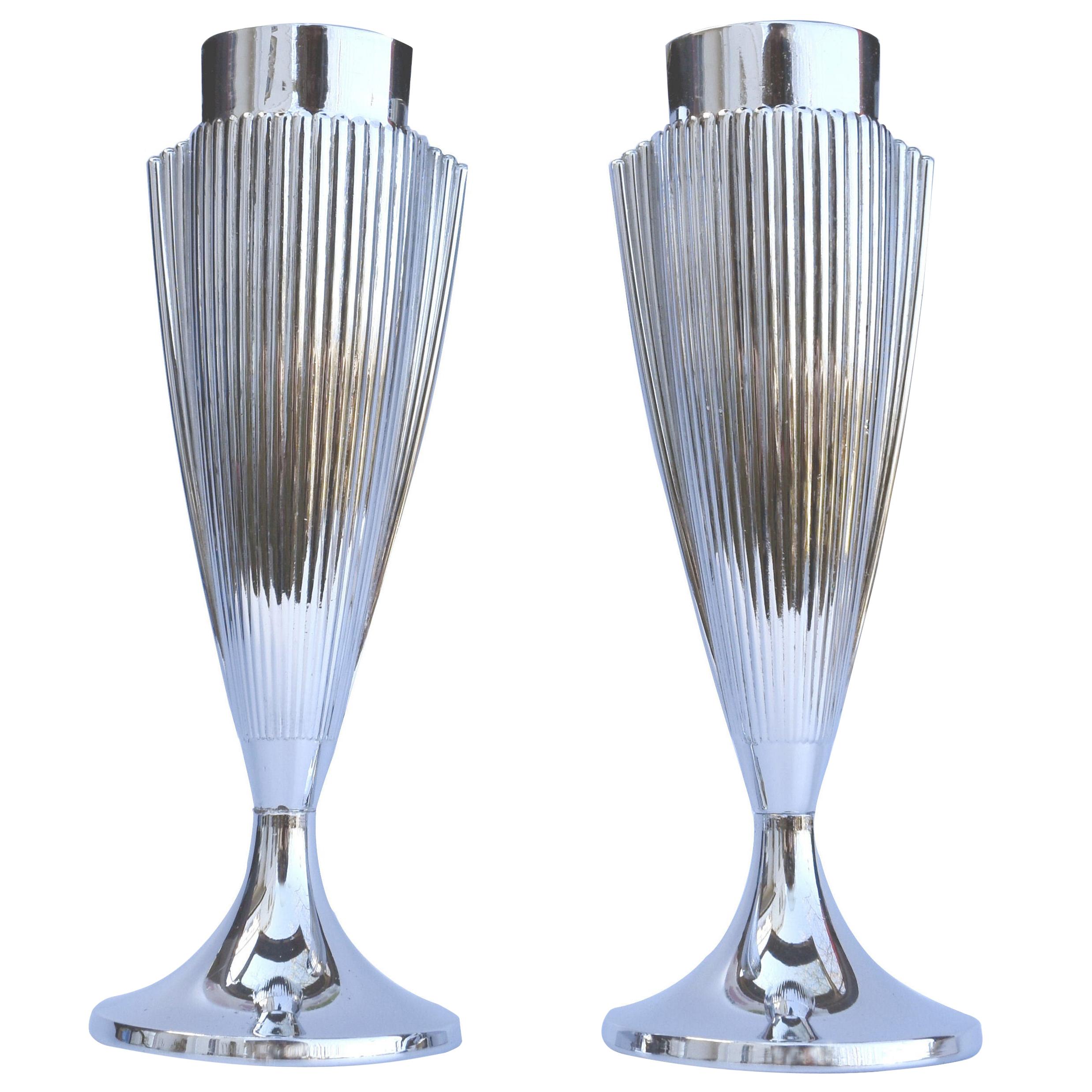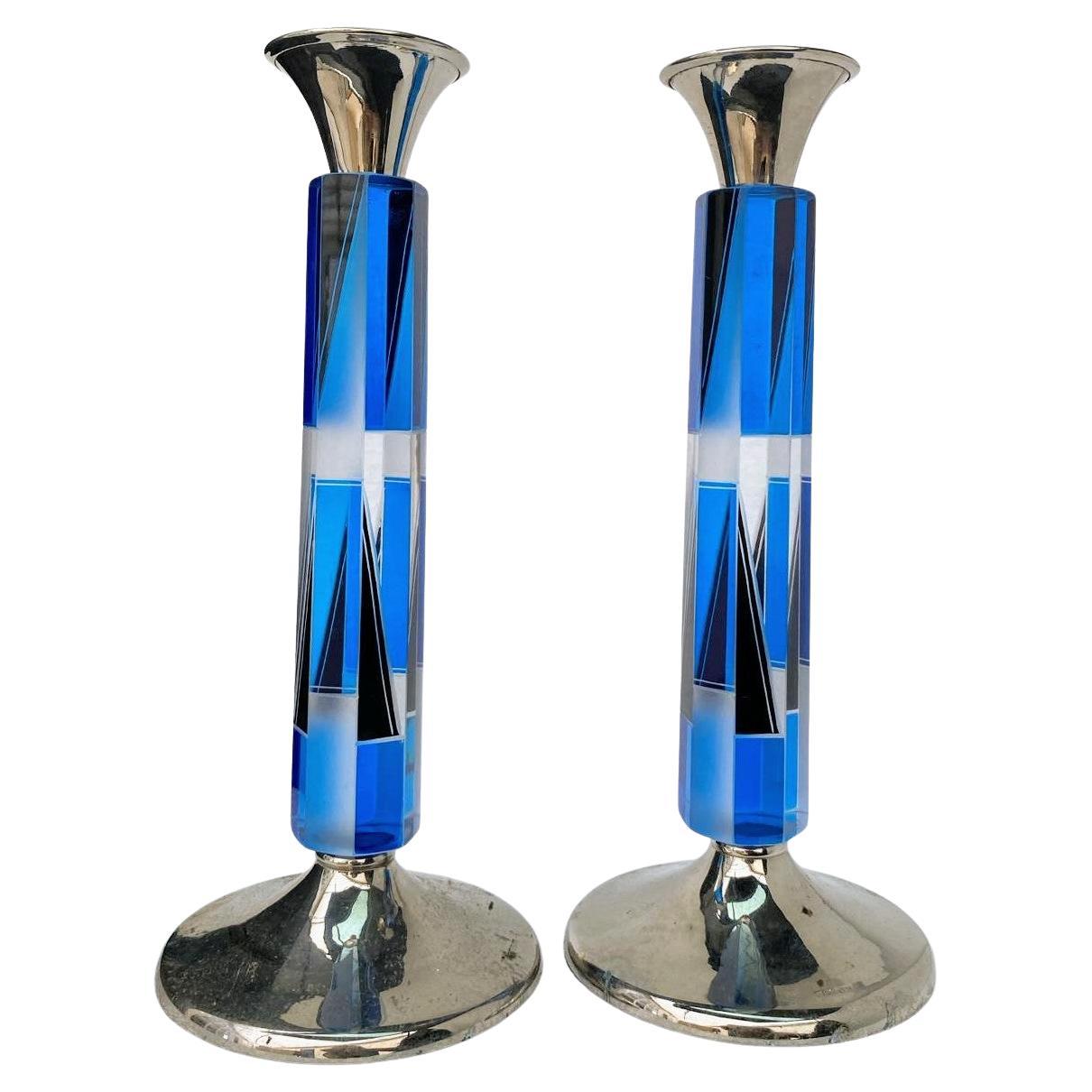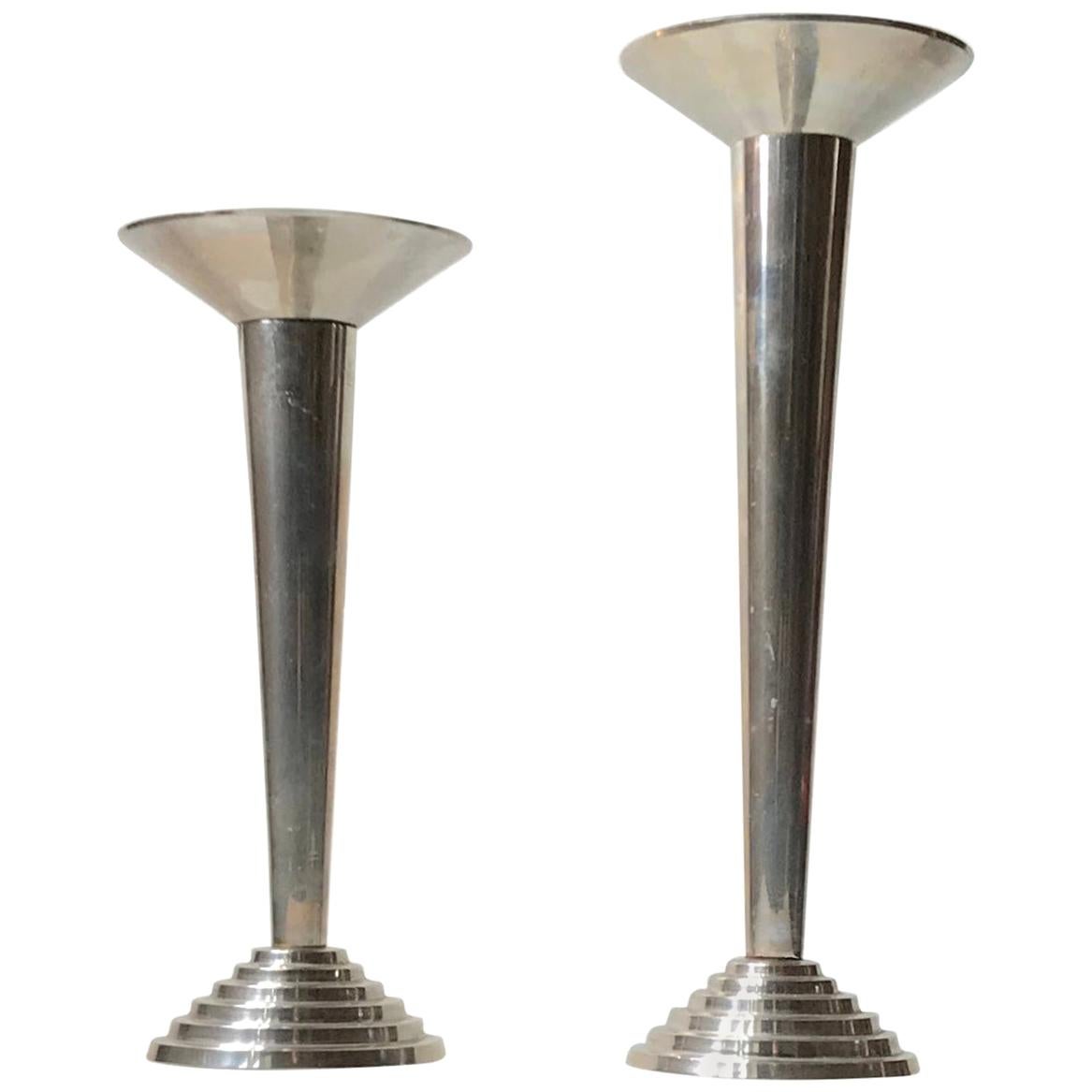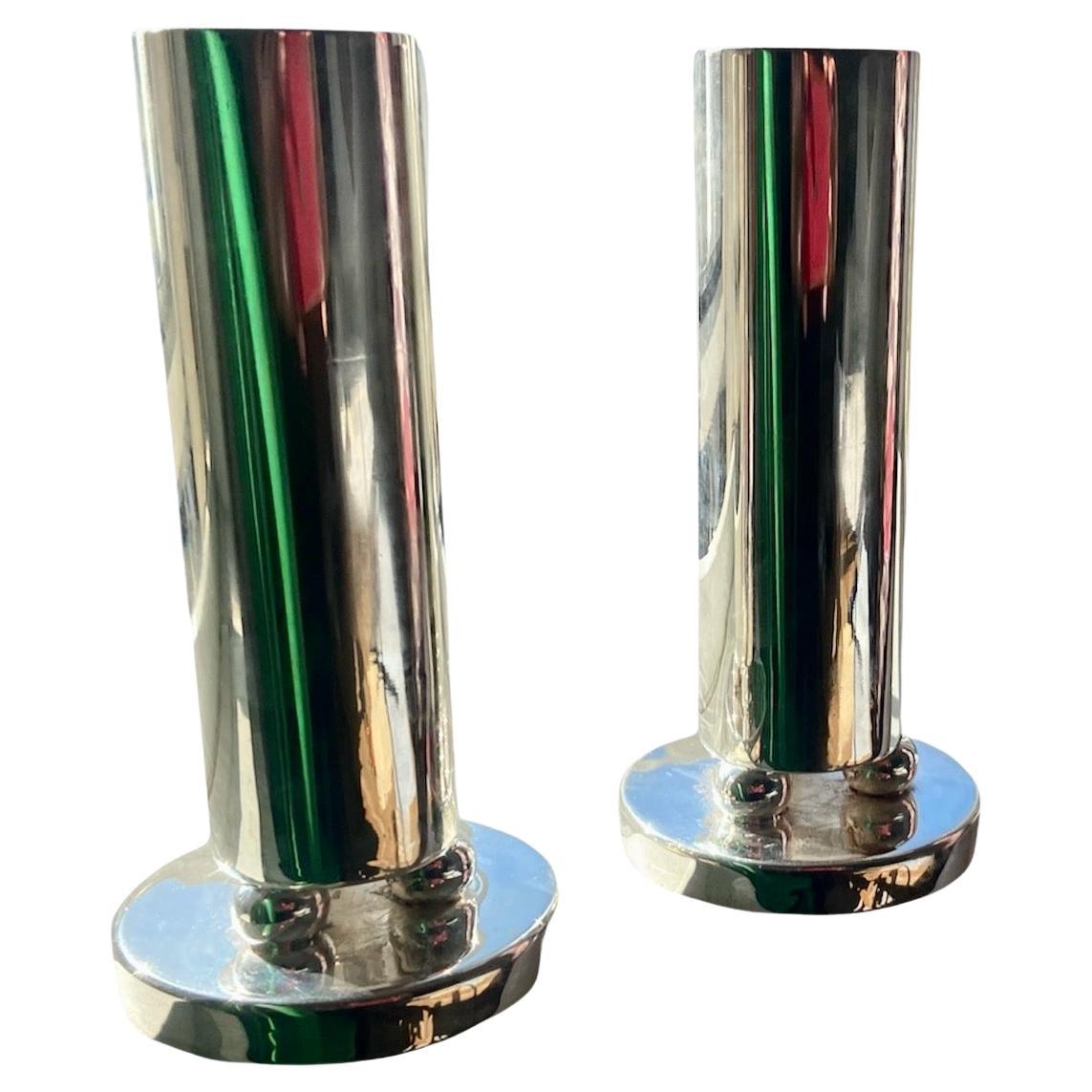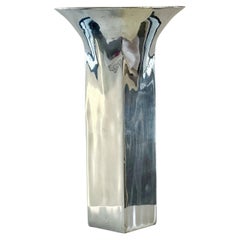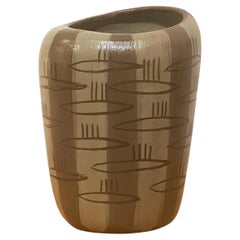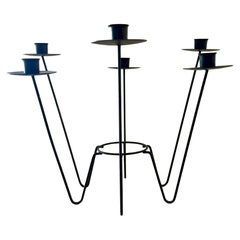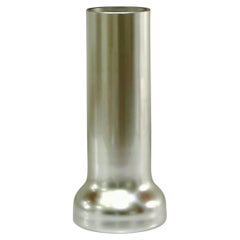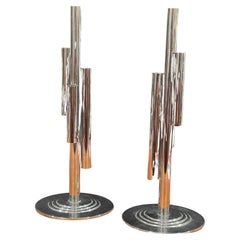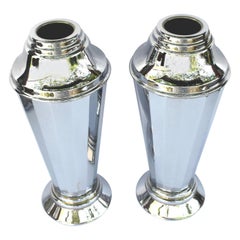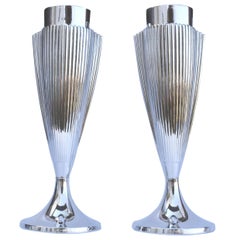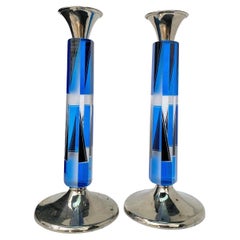Items Similar to American Deco Pair Chrome Bud Vases, ca 1930s
Want more images or videos?
Request additional images or videos from the seller
1 of 9
American Deco Pair Chrome Bud Vases, ca 1930s
$250per set
£188.52per set
€218.04per set
CA$350.75per set
A$389.88per set
CHF 204.37per set
MX$4,761.37per set
NOK 2,551.39per set
SEK 2,400.39per set
DKK 1,627.37per set
About the Item
American Deco Pair Chrome Bud Vases, ca 1930s
Unmarked, therefore listed as "in the style" of Chase and Co.
Original vintage condition and expected wear. Some scratches throughout and slight corrosion as seen in attached images but show well.
CHASE BRASS AND COPPER CO. was founded in Waterbury, Connecticut, in 1876 by Henry Sabin Chase. The company became one of the largest brass manufacturers in the city and continued to expand throughout the early 20th century, acquiring additional companies for the production of copper. The firm also produced consumer and industrial products including buttons, novelties, copper pipe, and plumbing supplies. During the 1930s, when demand for these types of goods declined due to the Great Depression, Chase, seeking to increase its business, entered the consumer market with a line of modern household goods in the Art Deco style, made of chrome-plated metal, copper, and brass. The stylish, streamlined wares were created by some of the leading industrial designers of the day, including Russel Wright, Rockwell Kent, Lurelle Guild, and Walter Von Nessen. They were usually signed with the distinctive company logo of a centaur drawing a bow. This specialty product line resulted in more than 500 decorative accessories, tableware, and lighting, designs, and lasted for only twelve years. Chase discontinued the line in the early 1940s when the company was engaged by the US government to produce war materials, such as shells and gun casings. Although the company still exists today, It is this short-lived line of decorative housewares for which Chase is most well known. These items are highly sought after today by collectors of American streamlined Art Deco. Chase moved from Waterbury, Connecticut in 1975. Today, Chase Brass and Copper Company, LLC is based in Montpelier, Ohio.
RUTH GERTH was born in Illinois in 1897. By her late teens, she had developed a keen interest in art and design, and pursued her education at the Chicago Art Institute. From the 1920s onwards, she was active as an illustrator and an interior and industrial designer. After her marriage to the architect William Gerth, the couple established the design studio Gerth & Gerth, which specialized in metalwork. The firm was responsible for the design of over 1000 objects, ranging from a radio and a man's electric razor to a watering can.
During the 1930s and 1940s, Her most prominent client was the Chase Brass & Copper Company of Waterbury, Connecticut, for whom she designed novelties and planned the offices, gift shop, showrooms, and accessory displays in the company’s new offices in the Chase Tower in Manhattan in the 1930s. In an article in the September 1933 issue of ‘Design’, it was commented that "Ruth Gerth [was] one of the more resourceful industrial designers" for Chase (p.10). She was known for her ability to recycle discarded material and old stock at Chase and ‘reimagine’ the shapes into some of their best-selling pieces. A number of her designs for Chase were patented. A candleholder designed by Gerth & Gerth for Chase is illustrated in ‘The Machine Age in America 1918-1941’ by Richard Guy Wilson, Dianne H. Pilgrim, and Dickran Tashjian (New York, NY: Brooklyn Museum of Art/Harry N. Abrams, Inc., 1986 p.326). Ruth Gerth also designed lanterns for the R.E. Dietz Company.
She was a member of the Society of Illustrators and the Artists Guild, an association of freelance artists which had been founded in 1920 to promote fair practices for the employment of freelance artists. She served as their president in 1936.
In the late 1940s, with the jewelry designer Milton Cavagnaro (1913-1993), the photographer and lithographer Leo Holub (1916-2010), and the architect and furniture designer George Kosmak, the Gerths formed the multidisciplinary design group Design Development in San Francisco.
Ruth Gerth’s work was exhibited at the Metropolitan Museum of Art in New York City; the Museum of Modern Art in New York City; and the Art Institute of Chicago in Chicago, Illinois. Among awards she received was the first prize in the American Face Brick Association contest for face brickwork for garden and grounds of residences (late 1920s or early 1930s). Ruth Gerth dies in 1952. - Source: Modern Redux
- Similar to:Chase Brass and Copper Company (Manufacturer)
- Dimensions:Height: 9 in (22.86 cm)Width: 3.5 in (8.89 cm)Depth: 3.5 in (8.89 cm)
- Sold As:Set of 2
- Style:Art Deco (Of the Period)
- Materials and Techniques:
- Place of Origin:
- Period:
- Date of Manufacture:Circa 1930s
- Condition:Wear consistent with age and use. Original vintage condition and expected wear. Some scratches throughout and slight corrosion as seen in attached images but show well.
- Seller Location:Cathedral City, CA
- Reference Number:Seller: OC 97491stDibs: LU8352241385762
About the Seller
5.0
Gold Seller
Premium sellers maintaining a 4.3+ rating and 24-hour response times
Established in 2000
1stDibs seller since 2023
23 sales on 1stDibs
Typical response time: <1 hour
- ShippingRetrieving quote...Shipping from: Cathedral City, CA
- Return Policy
Authenticity Guarantee
In the unlikely event there’s an issue with an item’s authenticity, contact us within 1 year for a full refund. DetailsMoney-Back Guarantee
If your item is not as described, is damaged in transit, or does not arrive, contact us within 7 days for a full refund. Details24-Hour Cancellation
You have a 24-hour grace period in which to reconsider your purchase, with no questions asked.Vetted Professional Sellers
Our world-class sellers must adhere to strict standards for service and quality, maintaining the integrity of our listings.Price-Match Guarantee
If you find that a seller listed the same item for a lower price elsewhere, we’ll match it.Trusted Global Delivery
Our best-in-class carrier network provides specialized shipping options worldwide, including custom delivery.More From This Seller
View AllMichael Lax Design Grainware METAAL Vase, circa 1992
By Michael Lax
Located in Cathedral City, CA
Measures 12-3/4” high, 7-1/2” wide at the mouth, 2-7/8” wide at the base.
Stamped on base
METAAL
Grainware c 1992
Michael Lax Design
ML-4012
There are some light scuffs and scratches especially toward the base, patina to finish. See images for detail.
Michael Lax (1929–1999) was an American industrial designer who created household products for companies such as Copco, Lightolier, Dansk, Salton, Metaal, Mikasa, Tupperware, and American Cyanamid. Several of his best-known products, including the Lytegem lamp by Lightolier and the Copco enamel...
Category
1990s American Post-Modern Vases
Materials
Aluminum
Lee Rosen Design Technics Incised & Slip Decorated Abstract Design Vase ca 1950s
By Lee Rosen, Design Technics
Located in Cathedral City, CA
Lee Rosen for Design Technics Incised and Slip Decorated Abstract Design Vase, ca 1950s
This is a gorgeous and unique Design Technics vase by Lee Rosen that features a biomorphic sh...
Category
Mid-20th Century American Mid-Century Modern Vases
Materials
Ceramic, Pottery
Midcentury Iron 6 Candle Candelabra, ca 1950s
Located in Cathedral City, CA
Midcentury Iron 6 Candle Candelabra, ca 1950s in the style of some of Van Keppel-Green's work in California in the 50s and 60s.
Composed of wrought iron rods bent and welded with si...
Category
Mid-20th Century American Mid-Century Modern Candelabras
Materials
Iron
Karim Rashid for Leonardo Germany Limited Edition New Move Glass Vase, ca 1999
By Karim Rashid
Located in Cathedral City, CA
Karim Rashid for Leonardo Germany Limited Edition New Move Silver Glass Vase, ca 1999.
Measures 8” high, base 3-1/2” wide, and mouth 2-1/4” wide.
There is a small scratch of silver finish/coating on glass (we've posted an image of the interior and exterior at the area of the scratch). There is also a faint area of small blemishes at the base See images for more detail.
If there’s one thing karim rashid hates, it’s trophies. The 40-year-old designer has more than 40 of them, from big international ones like the 1999 George Nelson Award (given for breakthrough furniture design), to quaint little Canadian ones like Designer of the Year 2001. “It came with a little pin,” says Rashid, “and a … a … very nice …” He tries to describe the shape of the award with his hands but gives up. “It’s time that whole trophy thing changes. It’s kitsch. They’re functionless things.” Rashid was asked to design one for the DaimlerChrysler Design Awards (he’s a past recipient). “I was going to make it electro-luminescent. When the lights go out, it has a sensor so it turns on,” he says. But the trophy-as-night-light, a reminder of one’s worth in the darkest hours, didn’t impress Chrysler’s people. He never heard back.
They may well be gnawing their knuckles over that decision right now because Rashid’s conquest of the realm of product design is all but complete. A lush and suitably worshipful retrospective of his work, Karim Rashid: I Want to Change the World (Thames & Hudson; 249 pages), hits Australasian bookstores this month. There was a crowd around anything with his stamp on it-including stools, chess sets and storage units-at the recent International Contemporary Furniture Fair in New York City. More than 2 million North Americans are throwing their rubbish into a receptacle he designed, while 750,000 or so park their rears on one of his cheapo plastic chairs. It’s not just in North America. He has been dubbed Der Poet des Plastiks by a retailer in Germany and the prolifico progettista Americano by Interni magazine in Italy.
Trophies he may despise, but accolades Rashid can handle. The problem with being the Most Famous Industrial Designer in All the Americas is that you’re still less famous than someone who got kicked off Survivor the first week. Most people cannot name the designer of one nonclothing item in their homes. Rashid, who was born in Egypt, raised in Canada and is living in New York City, is more than happy to bring an end to this anonymity. Not just because he wants to be famous, although there seems to be that, but because he believes design should be a bigger part of the social discourse. “I have been almost alone in this country, trying to make design become a public subject,” he says.
His chief method of persuasion is to make the banal better so that people notice design more. He likes creating expensive furniture and perfume bottles just fine, but what really gets his juices going is the everyday: manhole covers, a cremation urn, disposable cigarette lighters, garbage bins, salt and pepper shakers, plastic pens. “I want American Standard to come to me to do the toilets for Home Depot,” he says.
In many ways Rashid is more like an itinerant industrial evangelist than a designer. He traveled 200 days last year. He claims to have been to every major mall in America, where he signs his products in high-end design stores and trolls about observing humans interacting with the objects around them. He has taught at design schools for more than a decade, and his work has been in 11 art shows in the past eight months. But mostly he has proselytized the corporate barbarians. And like any good missionary, he has learned to speak the language of his converts. One of the first things he does when he gets new clients is tour their factories to understand their manufacturing capacity. He also visits the retail outlets to see how the product might be displayed. And he really knows how to sell, especially himself. “I work with a guy in L.A.,” says Rashid, declining to name him. “He made a lot of really bad furniture. His business was hand-to-mouth. I proposed seven or eight projects. The pieces I’ve done for him have already become iconic.” The subtitle of his monograph, I Want to Change the World, is not ironic, just characteristically immodest.
“Most industrial-design studios try to interpret a client’s needs and come up with a style,” says Paul Rowan, co-founder of housewares manufacturer Umbra. “Karim has his own personal vision.” It helps that Rashid’s vision incorporates things that Rowan needs, like a design that will stack and ship easily and that creates little waste in the making.
Rashid’s father was a set designer for Canadian TV who rearranged the family furniture every Sunday. So perhaps it was ordained that Karim would grow up to become one of the pioneers in non-cheesy plastic, making objects that have energy and personality but aren’t wacky. He, like many of his generation, has championed the could-only-be-designed-with-computers blob. But his is not just a blob for its own sake. His Oh Chair...
Category
1990s German Minimalist Vases
Materials
Blown Glass
Peter Pepper Products Palos Verdes California Surfboard Candle Holders ca 1950s
By Peter Pepper Products
Located in Cathedral City, CA
Peter Pepper Products Palos Verdes California Surfboard Candle Holders ca 1950s
Fun and original set of four 1950s wall sconces manufactured by Peter Pepper Products in Palos Verdes, California, ca 1950s. The sconces are purple, orange, green and blue carved wood planks...
Category
Mid-20th Century American Mid-Century Modern Candle Sconces
Materials
Metal
Art Nowo for Elmar Flototto, Germany Postmodern Cactus Lamp Set of Three ca 1990
By Elmar Flötotto
Located in Cathedral City, CA
Art Nowo for Elmar Flototto, Germany Postmodern "SUCU" Cactus Lamps, ca 1990
The set consists of two larger lights measuring 30” high x 14” diameter, and one smaller light measuring...
Category
Late 20th Century German Post-Modern Table Lamps
Materials
Metal
You May Also Like
Pair of Art Deco Tubular Chrome Bud Vases by Ruth & William Gerth for Chase Co
By Chase and Co., Ruth and William Gerth
Located in San Diego, CA
Wonderful pair of Art Deco tubular chrome bud vases by Ruth & William Gerth for Chase & Co., circa 1930s. The design features a central chrome tube attached to which are three tubes ...
Category
20th Century American Art Deco Vases
Materials
Chrome
$480 Sale Price / set
20% Off
Art Deco Matching Pair Of Chrome Vases, circa 1930
Located in Devon, England
Staple diet of any Deco collection is chrome ware and these are a perfect addition featuring a matching pair of tall Art Deco chrome conical shaped vases with weighted bases. The chr...
Category
Mid-20th Century English Art Deco Vases
Materials
Chrome, Iron, Sheet Metal
Art Deco Matching Pair of Chrome Vases, England, c1930
Located in Devon, England
Quite a rare find. A complete matching pair of 1930s original chrome "Rocket" shaped vases of high quality. Beautifully constructed and quite weighty you can display your arrangement...
Category
Mid-20th Century English Art Deco Vases
Materials
Chrome
Art Deco Matching Pair of Nickel-Silver & Glass Candlesticks, c1930
Located in Devon, England
Superbly stylish and good sized pair of matching 1930s Art Deco candlesticks. Hallmarked nickel-silver bases and with tall glass columns. Lovely condition and one Art Deco admirers w...
Category
Mid-20th Century European Art Deco Candlesticks
Materials
Silver Plate, Nickel
Art Deco Candlesticks in Steel, Germany, 1930s
Located in Esbjerg, DK
A set of Art Deco styled candlesticks. 'Staired' architecturally inspired base in engine turned aluminium. The tubes and candle holder are stan...
Category
Vintage 1930s German Bauhaus Candlesticks
Materials
Aluminum, Stainless Steel
$329 Sale Price / set
20% Off
pair of Arthur Krupp re-silvered 1950s Soliflore vases attributed to Gio Ponti.
By Arthur Krupp, Gio Ponti
Located in London, Fitzrovia
A pair of silver plated Soliflore vases / candle holders of unusual geometric balls design, by Arthur Krupp, Milano, and most probably designed by Gio Ponti.
Provenance: The Vienna ...
Category
20th Century Italian Mid-Century Modern Candlesticks
Materials
Metal
More Ways To Browse
1930s Furniture New York
Chase Plates
Chase Deco
Art Deco Chase
Antique Brass And Copper
American Of Chicago Furniture
Old Company Plate
Art Deco Black And Chrome
Antique Brass Shells
Antique Decorative Brass Plates
Metropolitan Furniture Company
Antique Copper Still
Copper Watering Can
Brass Gun
Antique Industrial Machines
Shell Casing
William Kent Furniture
Chrome Art Deco Display
